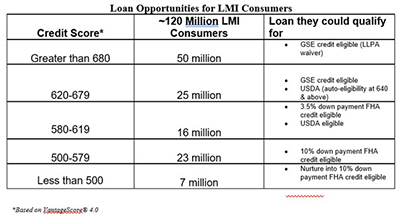
TransUnion: LMI Consumers Present $300 Billion Growth Opportunity for Mortgage Industry

Low-to-moderate income consumers have traditionally been overlooked in the mortgage market and trail non-LMI consumers in terms of homeownership. A new study from TransUnion, Chicago, suggests closing this gap could yield mortgage lenders as much as ~$300 billion in refinance and purchase originations.
The report said nearly 120 million consumers – equivalent to 50% of the credit-active U.S. population – are considered to be LMI consumers; and as many as 95% of these consumers are credit-eligible for a mortgage. These consumers are typically defined as having a credit score above 500 and exist across income levels; as many as 65% have an income greater than $50,000.
As such, said Joe Mellman, senior vice president and mortgage business leader at TransUnion, this segment of the population can offer mortgage lenders a “significant growth opportunity.” The report noted many LMI consumers may qualify for loans through the Federal Housing Administration or through the government-sponsored enterprises. Mellman said originating more of these types of loans can not only help close the wealth and homeownership gap, banks and credit unions can also earn Community Reinvestment Act lending and service credits and become another source of revenue for mortgage lenders.
“Many financial institutions are interested in expanding financial inclusion efforts to better serve low-to-moderate income consumers and communities,” Mellman said. “However, they may not have the right tools at their disposal to find and reach specific LMI consumers who are in the market for a home purchase or may benefit from refinancing. This can be a real win-win for lenders and consumers – lenders can grow their business by increasing awareness to consumers that can benefit and consumers are able to realize their dream of homeownership or save money with a refinance.”
The TransUnion study looked at the credit active population of LMI consumers from Q3 2019 to Q3 2020 and found a significant disparity in the number of LMI consumers with a refinance or purchase mortgage in comparison to the non-LMI cohort.
LMI consumers, for example, are 38% less likely to get a refinance and 34% less likely to get a purchase mortgage than non-LMI consumers. Should lenders take steps to close this gap, it could result in nearly one million more refinance loans and purchase loans and yield as much as $300 billion.
LMI consumers, however, often assume that they may not have sufficient credit to qualify for certain mortgage products. According to a recent TransUnion Consumer Pulse Survey, nearly half of the 601-660 credit score population incorrectly assumed their credit scores are too low to qualify for a mortgage. Yet, many of these consumers are likely credit eligible for FHA or GSE loans.
When LMI consumers do apply for a mortgage, the study found there is also disparity in the funding rates in comparison to the non-LMI group. LMI applicants are 22% less likely to get a refinance loan funded and 38% less likely to get a purchase loan funded than the non-LMI group. This discrepancy could potentially stem from many LMI consumers being unprepared to navigate the mortgage process.
“Several factors are used to determine whether an LMI consumer is credit eligible,” said Henry Cason, CEO of FinLocker, St. Louis, Mo. “By helping them understand where they stand on their path to mortgage readiness prior to their application, will provide a better overall experience and aid more LMI consumers in refinancing their home or making the transition to becoming homeowners.”
The study said lenders can also better tap into this segment by accurately finding consumers that are likely to qualify, and by looking at factors such as estimated income, census tract and homeownership vs. renter status, in addition to credit score.
